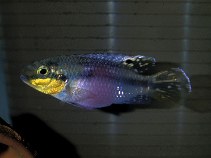| Family: |
Cichlidae (Cichlids), subfamily: Pseudocrenilabrinae |
| Max. size: |
5.34 cm SL (male/unsexed) |
| Environment: |
demersal; freshwater; brackish; pH range: 6 - 8; dH range: 5 - 19, |
| Distribution: |
Africa: coastal areas from Libreville (Gabon) to the lower Congo (Moanda) (Ref. 81260). Report from southeast Nigeria (Ref. 5677) is questionable and needs confirmation. |
| Diagnosis: |
Dorsal spines (total): 15-16; Dorsal soft rays (total): 9-9; Anal spines: 3-3; Anal soft rays: 7-8. Diagnosis: if present mid-lateral band does not extend over caudal fin; dorsal fin without dark basal band; relatively deep-bodied (body depth 35.6-41.6%, mean 37.4% standard length), distance from snout to pelvic fin origin 37.5-45.9% standard length (Ref. 81260).
Description: relatively robust species (body depth 34.6-41.6%, mean 37.4% SL), head length 32.2-38.9% SL; dorsal head profile smoothly rounded to snout; snout blunt, 23.4-30.9% HL; ventral body wall gently rounded to caudal peduncle which is deeper than long; distance from snout to pelvic origin 37.5-45.9%, mean 40.6% SL; 7-9 tuberculate rakers on hypobranchial and ceratobranchial, 5-8 epibranchial gill rakers; caudal fin rounded in both sexes, sometimes upper half somewhat elongate and lobe-like in males; sexual dimorphism well-developed with males usually 15-25% larger than females, with soft dorsal and anal rays more elongated (Ref. 81260). Caudal fin rounded to slightly rhomboid in large males (Ref. 52307).
Coloration: body brown or yellow-brown, dorsum and caudal peduncle darker than ventrum; cheek, opercle and chest yellow (Ref. 81260). Body scales of males with dark distal margins (Ref. 52307, 81260). Sometimes, especially in stressed individuals or when guarding fry, a black mid-lateral band is visible; when present, mid-lateral band passes from ventral border of eye to end of caudal peduncle and does not extend over caudal fin; dark lachrymal stripe present (Ref. 81260). Chest and belly in ripe females with a dark red or violet blotch, surrounded by a more or less developed iridescent silvery band (Ref. 52307, 81260). In courting females region directly behind head and caudal peduncle jet black; leading edge of pelvic blue, rest of fin purple; 4-5 pale bars or blotches sometimes visible on upper flanks in males; soft dorsal and upper lobe of caudal fin in males with red margin; dorsal fin in males yellow or red with light blue maculae in soft dorsal membrane; dorsal in females silvery white, with soft dorsal yellow and sometimes also with a few large black spots; upper third of caudal in males brownish with yellow dots and stripes; centrally, fin red with numerous rows of blue maculae, lower edge of caudal yellow; caudal in females clear to slightly yellow with some bright yellow spots; anal in males red with many rows of small blue maculae in posterior field, anal in females clear or slightly yellow (Ref. 81260). |
| Biology: |
Pair-bonding (Ref. 52307), cave-spawning (Ref. 52307, 81260), substrate brooder (Ref. 81260). |
| IUCN Red List Status: |
Least Concern (LC); Date assessed: 17 October 2019 Ref. (130435)
|
| Threat to humans: |
harmless |
| Country info: |
|
Source and more info: www.fishbase.org. For personal, classroom, and other internal use only. Not for publication.

